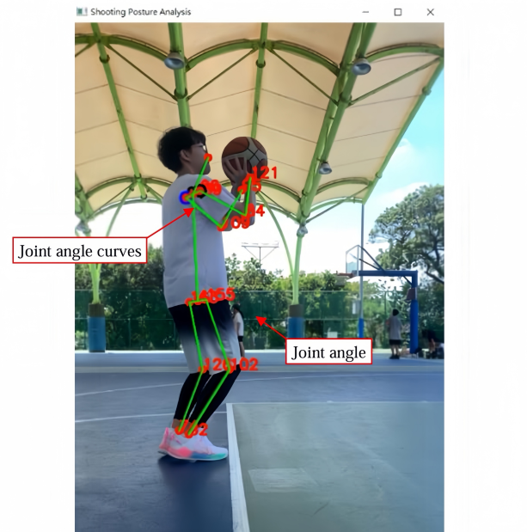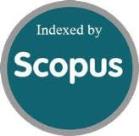Development and Application of a Body Joint Angle Detection System for Free-Throw Shooting Prediction and Posture Correction
DOI:
https://doi.org/10.46604/ijeti.2024.13851Keywords:
machine learning, joint angle, free throw, shooting prediction, posture correctionAbstract
The success rate of free-throw shooting is often a critical factor in determining game outcomes. This study employs machine learning to develop a low-cost, hardware-free joint angle measurement system for free-throw shooting and applies it to the scientific training of free-throw shooting skills. With the system, the joint angle curves of players can be measured without the need for reflective markers, thereby reducing setup costs and facilitating the integration of scientific training. This study presents several innovative features. The experimental results indicate that the amount of training data required for modeling is 50% of that required by the J48 decision tree classifier, with an accuracy 1.2 times higher. Additionally, when a shot is missed, the system compares the disparity in joint angles and provides feedback for posture correction, allowing players to target specific problem areas for training, improve free-throw performance, and assist the team in winning games.
References
C. C. Yu and D. M Hong, “Qualitative Analysis of Basketball Central Player 3-Point Jump Shoot,” Journal of Physical Education and Sports, vol. 8, no. 1, pp. 175-186, 1997. (In Chinese)
G. Palladino, “The Free-Throw-An In Depth Analysis,” The Basketball Clinic, vol. 12, no. 6, pp. 7-11, 1980.
R. Pim, “The Effect of Personal Fouls on Winning and Losing Basketball Games,” The Coaching Clinic, vol. 24, no. 4, pp. 14-16, 1986.
B. Kozar, R. E. Vaughn, K. E. Whitfield, R. H. Lord, and B. Dye, “Importance of Free-Throws at Various Stages of Basketball Games,” Perceptual and Motor Skills, vol. 78, no. 1, pp. 243-248, 1994.
P. Schulze, “Concentration-Key to Free-Throw Success,” The Basketball Clinic, vol. 13, no. 6, pp. 6-8, 1981.
R. Jenkins, “Win the Big Ones from the Foul Line,” Scholastic Coach, vol. 47, no. 5, pp. 88-89, 1977.
D. Hays and J. V. Krause, “Score on the Throw,” The Basketball Bulletin, vol. 12, no. 1, pp. 4-9, 1987.
M. J. Mersky, “Coaching and Teaching the Free-Throw Shooter,” The Basketball Clinic, vol. 19, no. 5, pp. 8-11, 1987.
B. Kozar, R. E. Vaughn, K. E. Whitfield, R. H. Lord, and B. Dye, “Importance of Free-Throws at Various Stages of Basketball Games,” Perceptual and Motor Skills, vol. 78, no. 1, pp. 243-248, 1994.
“STATISTIC,” https://pleagueofficial.com/stat-player/2022-23/2#record, accessed in 2023.
“National Basketball Association 2022-2023 Regular Season Team Statistics Rankings,” https://www.lottonavi.com/statistical/nba/points/2022-23-regular-season/, accessed in 2023.
Y. N. Chu, “The Difference in Basketball Beginners’ Free-Throw Shooting Accuracy with and without the Intervention of Pre-Performance Routines,” Master’s thesis, Education Department of Physical Education, National Kaohsiung Normal University, Kaohsiung, 2019. (In Chinese)
C. Y. Liang, “Especial Skill Effects on Basketball Free-Throw,” Master’s thesis, Department of Physical Education and Sports Sciences, National Taiwan Normal University, Taipei, 2012. (In Chinese)
L. Y. Lin, “From Old-Fashioned Hard Work to Scientific Training: The Practice of Sport Science in High School Volleyball League,” Sport Studies, vol. 39, pp. 135-180, 2021. (In Chinese)
“Dynamic Cycling Fit,” https://www.dynamiccyclingfit.com/global, accessed in 2024.
“The world's most advanced cycling analytics” https://www.velogicfit.com/, accessed in 2024.
“Optimize your Cycling Experience,” https://bikefitting.com/en, accessed in 2023.
“RETÜL Fit,” https://www.retul.com/retul-premium-fit, accessed in 2024.
W. L. Lee, “A Research to Field Goal through Lower Limb Joint Angle and Moving Jump Shot to Basketball,” Master’s thesis, Department of Physical Education, Fu Jen Catholic University, New Taipei, 2010. (In Chinese)
D. Mane, M. Deore, R. Ashtagi, S. Shinde, and Y. Gurav, “Basil Plant Leaf Disease Detection Using Amalgam Based Deep Learning Models,” Journal of Autonomous Intelligence, vol. 7, no. 1, article no. 1002, 2024..
R. Ashtagi, D. Mane, M. Deore, J. R. Maranur, and S. Hosmani, “Combined Deep Learning and Machine Learning Models for the Prediction of Stages of Melanoma,” Journal of Autonomous Intelligence, vol. 7, no. 1, article no. 749, 2024.
C. Lugaresi, J. Tang, H. Nash, C. McClanahan, E. Uboweja, and M. Hays, et al., “Mediapipe: A Framework for Building Perception Pipelines,” arXiv preprint arXiv:1906.08172, 2019.
Y. Quiñonez, C. Lizarraga, and R. Aguayo, “Machine Learning Solutions with MediaPipe,” 11th International Conference on Software Process Improvement, pp. 212-215, 2022.
B. Subramanian, B. Olimov, S. M. Naik, S. Kim, K. H. Park, and J. Kim, “An Integrated Mediapipe-Optimized GRU Model for Indian Sign Language Recognition,” Scientific Reports, vol. 12, article no. 11964, 2022.
J. W. Kim, J. Y. Choi, E. J. Ha, and J. H. Choi, “Human Pose Estimation Using MediaPipe Pose and Optimization Method Based on a Humanoid Model,” Applied Sciences, vol. 13, no. 4, article no. 2700, 2023.
Y. Lin, X. Jiao, and L. Zhao, “Detection of 3D Human Posture Based on Improved Mediapipe,” Journal of Computer and Communications, vol. 11, no. 2, article no. 112008, 2023.
H. M. Shung, “The Relationship between Isokinetic Strength and Shooting Accuracy in Senior High School Basketball Male Players,” Unpublished Master’s thesis, Graduate Institute of Athletics and Coaching Science, National Taiwan University of Sport, Taichung, 2004.
G. R. Hamilton and C. Reinschmidt, “Optimal Trajectory for the Basketball Free Throw,” Journal of Sport Sciences, vol. 15, no. 5, pp. 491-504, 1997.
V. Bazarevsky and I. Grishchenko, “On-Device, Real-Time Body Pose Tracking with MediaPipe BlazePose,” https://ai.googleblog.com/2020/08/on-device-real-time-body-pose-tracking.html, accessed in 2023.
MediaPipe Pose https://developers.google.com/mediapipe/solutions/vision/pose_landmarker/, accessed in 2023.

Published
How to Cite
Issue
Section
License
Copyright (c) 2024 Cheng-Hsiu Li

This work is licensed under a Creative Commons Attribution-NonCommercial 4.0 International License.
Copyright Notice
Submission of a manuscript implies: that the work described has not been published before that it is not under consideration for publication elsewhere; that if and when the manuscript is accepted for publication. Authors can retain copyright in their articles with no restrictions. Also, author can post the final, peer-reviewed manuscript version (postprint) to any repository or website.

Since Jan. 01, 2019, IJETI will publish new articles with Creative Commons Attribution Non-Commercial License, under Creative Commons Attribution Non-Commercial 4.0 International (CC BY-NC 4.0) License.
The Creative Commons Attribution Non-Commercial (CC-BY-NC) License permits use, distribution and reproduction in any medium, provided the original work is properly cited and is not used for commercial purposes.







.jpg)


